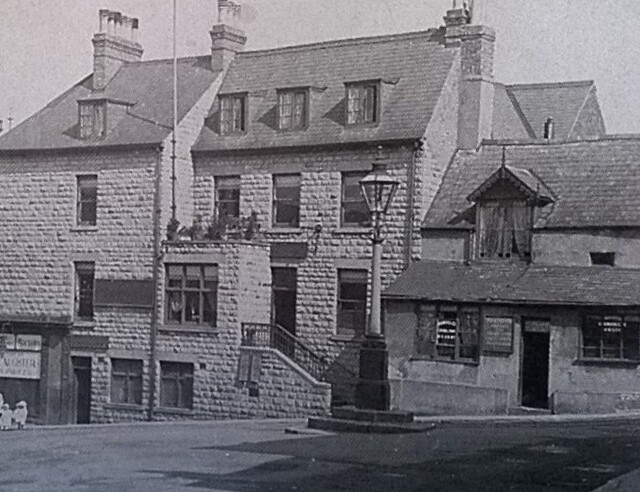» Main Index

» Search This Site

» Submit Update

» Contact Us


|
|

|
Home > Nottinghamshire >
Sutton In Ashfield > Durham Ox
Durham Ox
 |
|
Durham Ox on right. |
|
|
|
|
|
|
The Durham Ox was located on the Market
Place and the building is said to have dated from the reign of King James
II. (1686-1688) It joined the Denman’s Head on one side and was on the
corner of High Street and the marketplace.
Its name came from a famous animal known as 'The Durham Ox', which toured
around the country at the beginning of the 19th century. It was carried in a
specially constructed vehicle, drawn by four or six horses. The ox probably
tipped the scales around 2,400 pounds and stood five feet, five inches at
the shoulders. Records of its size exist because they were measured by
artist George Garrard for his 1802 painting "A Fat Holderness Ox called the
Wonderful Ox (The Durham Ox)."
A print of the Durham Ox painting, engraved in 1802 by John Boultbee, "sold
2,000 copies within the year, and was hung in homes, inns and coaching
houses".
We do not know when this building became an Inn, but its name would not have
occurred any earlier than 1802. The first known occupant was John Isaac
Evans, who was listed on the 1822 Alehouse Recognizances as occupying the
Durham Ox, before moving to the Old Blue Bell the following year.
The Clarke family spent more time than anyone at the Durham Ox. They arrived
around 1844, and William Clarke remained as landlord until 1874, when his
wife Mary took over the licence. This was most likely due to the death of
William, who would have been 65 in that year. Mary was last listed in the
Post Office directory for 1876, when she would have been 71 years old.
In 1877, William Houldsworth Walton was also an 'Ale and Porter Merchant', a
trade he had previously run on Church Street before moving to the Durham Ox.
In 1881 he was listed in the census as innkeeper, and a widower with four
young children, aged between 6 years and 1 month old. By 1900 he was listed
as owning the Crown Brewery.
A small fire occurred at the property in April 1887, and was noted in the
Mansfield Reporter of 28th April:
“Fire - On Sunday night last, a fire was discovered at the house of Mr.
Walton, the Durham Ox Inn, Sutton-in-Ashfield. A beam running into a chimney
appears to have caught fire, and the inmates were aroused by the smoke. The
fire was soon extinguished by means of buckets of water, and the damage
which resulted was not serious”
In 1894, William Henry Carver left the Durham Ox after filing for
bankruptcy.
In June 1908 the Nottingham Evening Post reported that the Durham Ox was one
of two pubs that would be closed. The owners at the time were the Home
Brewery Co., and the tenant was George Duckmanton. The only grounds given
for refusing to grant a renewal of the licence was the “unsuitability for
the requirements of the neighbourhood and redundancy”. They claimed that the
house was not required “there being too many in the neighbourhood”. This was
difficult to argue against, given its location, being sandwiched between the
Denman’s Head on one side and immediately opposite the Red White and Blue.
Another report, dated March 1908, provided additional information. The gross
rental of the house was £85 and its rateable value was £59 10s, and there
were eight licenced properties within 120 yards of the Durham Ox. It was
described as “a very old house, many of the rooms being small and low. It
did a very large trade, and was generally crowded during the evenings,
especially on Saturday nights”. Mr Duckmanton’s licence was “free for
spirits'' but tied to the Home Brewery Company for ale and minerals. The
house had been well conducted and no complaints had been made against it.
In addition, sales figures for beer and minerals had increased from £661 in
1905 to £820 in 1906 and £920 in 1907. The tenant confirmed that the
“average takings of the house amounted to £45 per week.
After considering all the evidence, the committee agreed that the property
should be dis-licenced but that compensation should be paid to the owners.
The building was demolished soon after, leaving an empty space behind the
Denman’s Head which was certainly reflected on the OS map of 1918. The Home
Brewery acquired the remaining land and built a wall and gate to create a
small rear yard for the Denman’s Head that still exists today.. |
|
|
|
Source: Heather Faulkes |
|
|
|
Do you have any anecdotes, historical information, updates or photos of this pub? Become a contributor by submitting them here. Like this site? Follow us on

You can also make email contact with other ex-customers and landlords of this pub by adding your details to this page. |
|
|